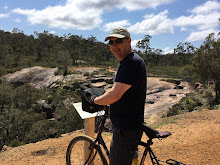When I started the blog again with the new build, I said I
would be more disciplined in keeping it updated – of course that hasn’t
happened.
I have been doing lots of things simultaneously as usual,
instead of focusing on one thing at a time. I really should know better. So over the next few posts, there’s some progress on the various aspects of the build.
 |
CONSTRUCTION
I have made a lot of progress with this. I have designed and constructed
the carcasses for the following elements.
Main Instrument Panel (MIP) – This is constructed out of 9mm
MDF and was designed by me on sketchup and cut with the big laser cutter at the
Artifactory. It is full-size and is a one-man cockpit, so has space for the
Captain side PFD (Primary Flying Display) and ND (Navigation Display) and the
central console housing the ECAM (Electronic Centralised Aircraft Monitor). I
have monitors in these spaces with the appropriate displays. I have also
fabricated a sliding table – just like in the real cockpit. I haven’t
fabricated the fronts yet. i can't until I get my displays sorted.
 |
| The MIP complete with sliding table |
Pedestal – This is the box that sits between the pilots and
houses the radios, flaps and speedbrake levers, and the MCDUs (Multi-function
Control Display Units). It is made from 9mm MDF and again was designed by me on
Sketchup and laser cut. Into this I have dropped a temporary switch panel that
houses all the commonly used buttons and switches from the pedestal,
glareshield and overhead. This enables me to use switches and buttons instead
of the mouse and keyboard for most common tasks. I have these hooked up to 3 x
USB joystick cards which gives me 36 digital inputs – almost enough (but not
quite!!). The Aerosoft Airbus model comes with the facility to push the MCDU to
a web browser so I’ve been using an iPad for this function at the moment.
 |
| The Pedestal - with temporary switch panel and throttle |
Overhead – This is the collection of panels that sits above
the pilots’ heads and houses the switches and buttons for all the aircraft
systems – lights, fuel, hydraulics, etc. I am now on version 3 of this carcass.
Every time I create a new version, I think of improvements. I have also created
a framework from high pressure PVC pipe that supports the Overhead in the
appropriate place – I just need to paint it black.
Glareshield – I have designed this on Sketchup on 9mm MDF
but haven’t cut it yet. The big laser cutter at the Artifactory has been temperamental
of late. This is a bit irksome, as I have a few things to cut.
Sidestick Box – This is a box at the pilot’s left arm for
the sidestick and nosewheel steering. I have designed this in 9mm MDF using
Sketchup and will laser cut it when the laser cutter is operational again.
Seat – I have rescued a car seat from the bulk rubbish
collection that was in good condition. I have built a box to stabilise it and
get it to the right height. It is on castors and I have an idea about how to
fabricate some J-rails. The space for the seat is very tight in a cockpit and
the seats move back and around (in a J shape) on rails to let the pilot in and
out.
 |
| The Seat in position |
_%22House_colors%22_F-WWBA_-_MSN_001_(10276181983).jpg)

